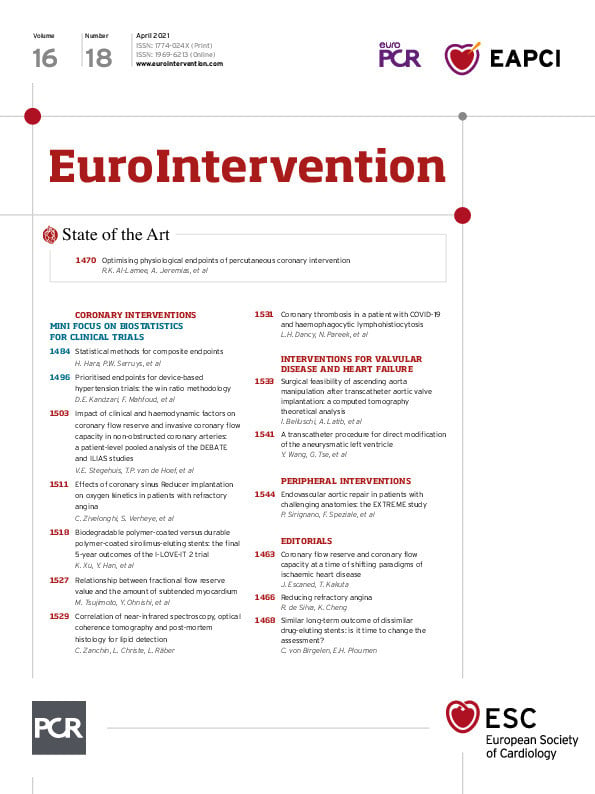
Long-term follow-up of randomised drug-eluting stent (DES) trials provides information that may be of great clinical value. While restenosis in DES generally occurs within the first two years, some safety and efficacy endpoints may only be seen at later stages. Most randomised trials that compared contemporary DES using Kaplan-Meier methods showed no significant difference in long-term outcome despite substantial between-DES differences in strut thickness, polymer type, stent design, and drug1,2,3. However, the inability to prove a difference is not the same as proof of no difference. In case of a negative trial result, in principle, there may be truly no difference, a lack of statistical power (type 2 error), or suboptimal methods used for assessment.
In this issue of EuroIntervention, Xu et al also report no between-DES difference in five-year clinical outcome in the I-LOVE-IT 2 trial, a well-performed and analysed, multicentre randomised trial that compared a biodegradable polymer sirolimus-eluting stent with a durable polymer sirolimus-eluting stent4.
In patients treated with the biodegradable polymer-coated DES, the trial also compared 6-month versus 12-month dual antiplatelet therapy (DAPT) and found similar rates of net adverse clinical and cerebral events at both 18-month and 5-year follow-up. Remarkably, there was no benefit in terms of bleeding events after shortening the duration of clopidogrel-based DAPT. We can only speculate that the fact that I-LOVE-IT 2 did not utilise the more potent P2Y12 receptor antagonists may have partly accounted for this finding.
As recently most randomised DES trials (including the I-LOVE-IT 2 trial) have reported similar long-term outcomes for dissimilar contemporary DES, it is of interest to evaluate potential explanations. A possible reason that has not been extensively discussed is that Kaplan-Meier methods may no longer be the ideal approach to evaluate contemporary DES with their increasingly low event rates. While the Kaplan-Meier approach is still considered the gold standard and allows the easy comparison of the results of different trials, some concerns about this method can be raised that may be particularly relevant for contemporary DES.
When using Kaplan-Meier methods, only the first event of a specific event type or composite clinical endpoint is included in the analysis. After that first adverse event, the statistical method no longer considers the patient to be “at risk” for any subsequent event of that type. For some events this is not an issue, such as for death which can occur only once. However, after a first repeat revascularisation there is still the possibility of subsequent repeat revascularisations which may have a substantial impact on the patient’s quality of life. In addition, by including repeat events, the event count per treatment arm increases, and the total sample size and costs of trials could be reduced while maintaining statistical power. Hence, as a step towards performing more cost-effective and patient-centred clinical research, investigators of future DES trials may consider including the assessment of repeat events.
Another concern may be the use of composite clinical endpoints as the main outcome parameter. After a patient has experienced any of the individual endpoints of the composite, the Kaplan-Meier method neglects other adverse events that may occur later on. In addition, for the analysis, all individual components of the composite endpoint are considered to be of equal clinical relevance and severity. Yet, in reality, this is highly questionable as, for instance, the severity of death is not equal to that of a repeat coronary revascularisation procedure5.
A few previous studies have explored the use of other methods for analysing randomised clinical trials6,7. For instance, the weighted composite endpoint method considers all consecutive events and the time-to-events, and it allows differentiation between the severity of events. It is within the bounds of possibility that the assessment of randomised DES trials with such a novel method may yield different results and reveal between-DES differences that otherwise could not be seen7. Nevertheless, this novel statistical method is somewhat more challenging, and it may take some time before achieving standardisation for common use.
The I-LOVE-IT 2 trial has collected high-quality randomised trial data of contemporary DES in a broad patient population and reported no between-stent difference in the five-year rates of ischaemic and bleeding events. The data collection and analysis of this study were performed according to current international standards. Yet, investigators of future DES trials may consider changing standards to facilitate the use of more patient-centred and cost-effective methods that consider the severity and repeatability of all relevant adverse clinical events.
Funding
C. von Birgelen reports that the Research Department of Thoraxcentrum Twente received institutional research grants provided by Abbott Vascular, Biotronik, Boston Scientific, and Medtronic.
Conflict of interest statement
The authors have no conflicts of interest to declare.
Supplementary data
To read the full content of this article, please download the PDF.

